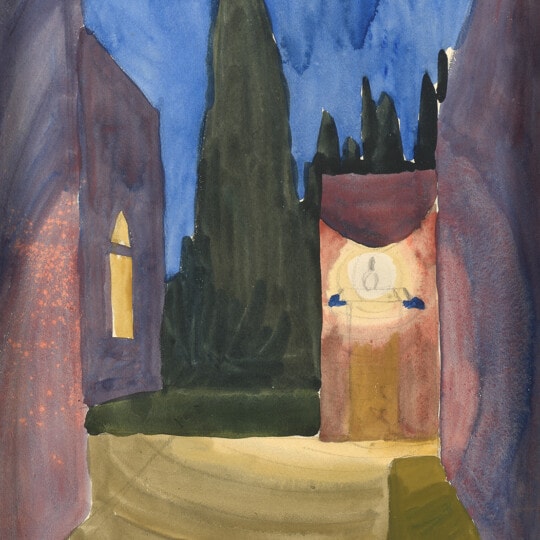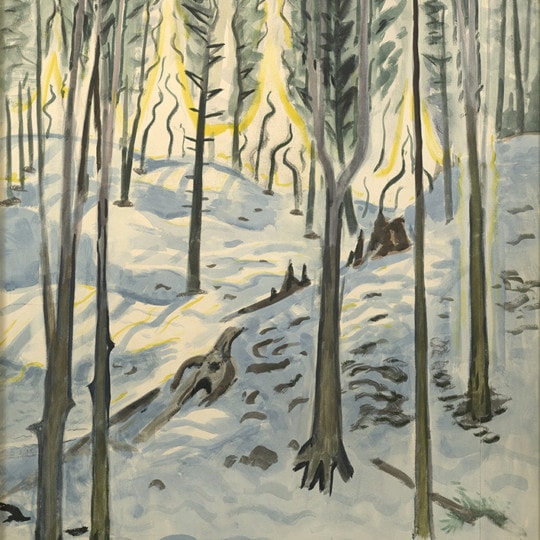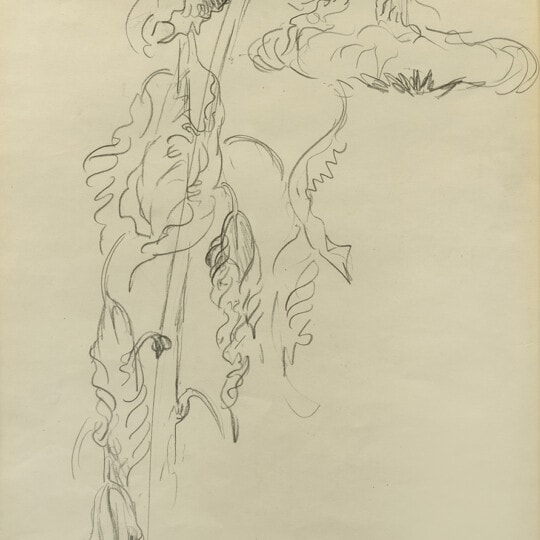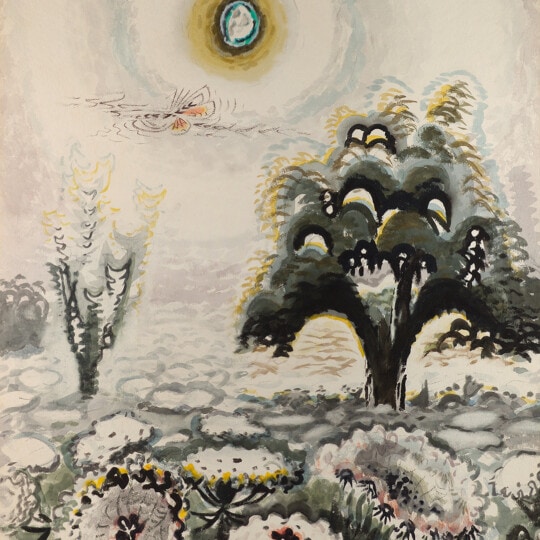Charles Burchfield
Artist Biography
Watercolorist with Romantic Realist Vision of American Life
By Amy Spencer
Best known for his romantic watercolors, Burchfield developed a unique style, swinging between realism and fantasy, to express his profound respect for the American landscape.
I. Biography
II. Chronology
III. Collections
IV. Exhibitions
V. Memberships
VI. Notes
VII. Suggested Resources
I. Biography
Charles Ephraim Burchfield is celebrated for his visionary paintings of the American landscape; from gritty industrial scenes, to tranquil rural towns, to turbulent landscapes. Working during the first half of the twentieth century, Burchfield’s watercolors of ‘the middle border’ (the American Mid-West) achieved significant critical and commercial success over the course of his career. Critics loved Burchfield’s Modern innovations which were neither entirely abstract nor representational, while audiences responded to the sincere affinity he expressed for his subjects.
Since his death in 1967, art historians have re-visited Burchfield’s oeuvre, praising the individualistic, and at times fantastical, paintings created by an artist who led a relatively prosaic life. Art critic Roberta Smith writes of Burchfield, “Charles Burchfield… was a down-home visionary, a painter of the American Scene who saw right through it to the inner life of natural forms, landscapes and even man-made structures.”1 Burchfield’s works are in all major collections of American Modernism, including the Whitney Museum of American Art, the National Gallery of Art, and the Museum of Modern Art. Recently, renewed interest in Burchfield’s work has stimulated strong auction results. In 2007, the artist’s record was set when Burchfield’s watercolor A Dream of Butterflies (1962) sold at Sotheby’s for $1,329,000 against a pre-auction estimate of $500,000 to $700,000.2
Burchfield was born on April 9, 1893 in Ashtabula Harbor, Ohio. Five years later, following the death of his father, his family moved to nearby town of Salem. After Burchfield graduated from high school in 1911, he attended the Cleveland School of Art where he intended to learn illustration. However, by his second year of art school, Burchfield’s attention had shifted as he became fascinated with the challenge of visually expressing the natural environment. As a twenty-one year old, Burchfield wrote in his journal, “I hereby dedicate my life and soul to the study and love of nature, with the purpose to bring it before the mass of uninterested public.”3
After graduating from college, Burchfield moved back to Salem, where he worked as an accountant for an automobile company. He painted devotedly in his spare time; on weekends, evenings, and even during his lunch hour at work. Burchfield’s paintings from these formative years are generally whimsical creations that reflect his obsession with nature, but also his fixation on childhood memories. He developed a style that merged calligraphic marks and strange abstractions into organic forms in order to express the transcendental nature of his landscapes. Within Burchfield’s enchanted paintings, objects are personified; flowers seem to have faces and tribal masks appear in the bark of trees.
In 1921, Burchfield moved to Buffalo, New York to begin working for M. H. Birge & Sons Company, one of America’s most prominent wallpaper companies. He married Bertha Kenreich, and over the next seven years they had five children together. Living in Buffalo influenced Burchfield’s painting significantly. From 1924 onwards, he adopted a more realistic style, as he became interested in objectively depicting architecture and the surrounding countryside. Tree lined streets, quaint churches, and store fronts are typical subjects from this early-Buffalo period. Many of his works have a slightly sinister quality to them that Burchfield’s biographers attest to his dissatisfaction with urban Buffalo. However in general, Burchfield’s simple compositions evoke a sense of neutrality towards his subjects which allows for a visual social commentary to emerge.
In 1929, after Frank K. Rehn Galleries began representing him in New York, Burchfield’s ensuing commercial success allowed him to resign his job and paint full-time. During this period Burchfield refined his objective style that emphasized the realities of American life during the Depression. Images of houses buried under snow, grain elevators, and lake freighters show minute figures going about their daily life, while being dwarfed by the cityscape around them. The dramatic scaling of his works created a sense of baroque drama, however these works also reveal a heightened sense of place and belonging. These moody scenes of Buffalo have often been compared to works by Burchfield’s contemporary and friend Edward Hopper. Hopper also painted in a style of romantic realism, however the two artists are essentially quite different. While Hopper created an artificial world of privilege fraught with boredom and anxiety, Burchfield cast a less contrived gaze over his world of relentlessly ordinary blue-collar workers. Burchfield lived the ‘middle border’ subjects of his paintings, he did not judge them.
Burchfield won numerous awards for his watercolors, and he exhibited frequently in public and private galleries throughout the 1930s. As his reputation grew he gained a number of important commissions, the first major one coming from Fortune magazine to paint the railroad yards at Altoona and Harrisburg in Pennsylvania. In 1930, Burchfield had a solo exhibition of his watercolors at the Museum of Modern Art in New York City.
In 1943, after years of commercial success, Burchfield decided to return to the subject and expression of his earlier work and bring nature “before the mass of uninterested public”. Burchfield’s return to personal expressionism, combined with his developed drafting skills, saw him produce artful and ambitious reconstructions of nature. To these heroic landscapes he added innovative abstract elements to convey pulsing sound and motion, as he recreated for the viewer the complete experience of being in the wilderness. This subject matter kept him occupied for the rest of his career.
Burchfield’s artistic achievements were recognized by numerous late-career retrospectives, the most comprehensive held at the Whitney Museum of American Art in 1956, and later traveled to five city museums. He was further honored with the opening of the Charles Burchfield Center at Buffalo State College in December, 1966. Burchfield died in West Seneca, New York on January 11, 1967.
Burchfield’s artistic oeuvre does not fit a single movement of Modern art, and unlike his contemporaries he did not travel overseas or seek inspiration from other paintings. Rather, Burchfield’s highly distinctive, almost idiosyncratic, style can be seen as intensely autobiographical. His watercolors of nature are personal, almost surreal, expressions of local landscapes, while his images of industry and city-streets convey an honest experience of urban life. In walking a line between abstract and representational art, Burchfield’s paintings were very modern for their time, and the legacy of these works resonates today as a defining vision of American life.
II. Chronology
1893 Born in Ashtabula Harbor, Ohio
1898 Moves to Salem, Ohio following the death of his father
1911 Graduates from high school as class valedictorian
1911-12 Works in the cost department of Mullins, an automobile company, to save money to go to art school to become an illustrator
1912 Attends Cleveland School of Art (now Cleveland Institute of Art), studying under Henry G. Keller, Frank N. Wilcox, and William J. Eastman
1916 Graduates and returns to Salem where he works for Mullins
Paints imaginative watercolors based on childhood memories in his spare time
Awarded scholarship to the National Academy of Design in New York City, quits after one day
Has small exhibition of paintings at Sunwise Turn Bookshop, New York
1918 Enters the military and serves as a camouflage artist for six months
1919 After being discharged from the army he returns to work for Mullins
1920 First one-man gallery exhibition is held at the Kevorkian Galleries, New York
1921 Moves to Buffalo, New York and begins working for M. H. Birge & Sons Company, one of America's most prominent wallpaper companies
1921-43 Adopts a more realistic style, as he becomes interested in objectively depicting architecture and the surrounding countryside
1922 Marries Bertha Kenreich (they have five children between 1923 and 1929)
1924 The Metropolitan Museum of Art purchases The False Front
1925 Moves to Gardenville, West Seneca, an outer suburb of Buffalo
1928 Edward Hopper’s essay on Burchfield appears in Arts magazine, Burchfield and Hopper begin friendship
1929 The Museum of Modern Art purchases Noontide in Late May
Frank K. M. Rehn Galleries in New York City begins representing Burchfield
Resigns from his job as a designer to paint full-time
1930 Early watercolors are shown in a solo exhibition at the Museum of Modern Art
1934 Participates in the 19th International Biennial Art Exhibition, Venice, Italy
1935 Featured in Thomas Craven’s Harper’s Magazine article, ‘Our Art Becomes American’
1936 Commissioned by Fortune magazine to paint railroad yards in Pennsylvania
Life magazine prints the story, ‘Burchfield’s America’
1937 Commissioned again by Fortune magazine to paint sulphur and coal mines in Texas and West Virginia
1943+ Returns to painting fantasy scenes that are more personal interoperations of nature
1949-53 Teaches courses periodically at the Art Institute of Buffalo; Ohio University, Athens; University of Buffalo; University of Minnesota, Duluth; and Buffalo Fine Arts Academy
1954 Is one of several artists who paints advertisements for Johnnie Walker scotch
1956 John H. Baur curates a retrospective of Burchfield’s work at the Whitney Museum of American Art, followed by a five-venue tour
1966 The Charles Burchfield Center opens at Buffalo State College with an inaugural exhibition of his recent works
1967 Dies of a heart attack in West Seneca, New York on January 11
III. Collections
Addison Gallery of American Art, MA
Art Institute of Chicago, IL
Bowdoin College Museum of Art, ME
Brauer Museum of Art at Valparaiso University, IN
Burchfield-Penney Art Center, NY
Butler Institute of American Art, OH
Canton Museum of Art, OH
Carnegie Museum of Art, PA
Cleveland Museum of Art, OH
Columbus Museum of Art, OH
Currier Gallery of Art, NH
Dallas Museum of Art, TX
Everson Museum of Art, NY
Farnsworth Art Museum, ME
Fine Arts Museums of San Francisco, CA
Fred Jones Jr. Museum of Art at the University of Oklahoma, OK
Harvard University Art Museum, MA
Hirshhorn Museum and Sculpture Garden, DC
Hunter Museum of American Art, TN
Kemper Museum of Contemporary Art, MO
Memorial Art Gallery at the University of Rochester, NY
Memphis Brooks Museum of Art, TN
Metropolitan Museum of Art, NY
Midwest Museum of American Art, IN
Mint Museum of Art, NC
Montclair Art Museum, NJ
Munson-Williams-Proctor Arts Institute, NY
Museum of Fine Arts, MA
Museum of Modern Art, NY
National Gallery of Art, DC
Pennsylvania Academy of Fine Arts, PA
Phillips Collection, DC
Samek Art Gallery at Bucknell University, PA
San Diego Museum of Art, CA
Smith College Museum of Art, MA
Smithsonian American Art Museum, DC
Southern Alleghenies Museum, PA
Springfield Museum of Art, OH
Sweet Briar College Art Gallery, VA
Tate Britain, London, England
Terra Foundation for American Art, IL
Tweed Museum of Art at the University of Minnesota, MN
Vero Beach Museum of Art, FL
Walker Art Center, MN
Westmoreland Museum of American Art, PA
Wichita Art Museum, KS
Whitney Museum of American Art, NY
IV. Exhibitions
1916 Sunwise Turn Bookshop, New York, NY
1918 Laukhuff’s Bookstore, Cleveland, OH
1920 Kevorkian Galleries, New York, NY
1921 Harvard Liberal Club, Harvard University, Boston, MA
Paintings by American Artists, Brooklyn Museum of Art, New York, NY
1923 Grosvenor Galleries, London, England
1924 Montross Gallery, New York, NY
1929 Paintings by Nineteen Living Americans, Museum of Modern Art, New York, NY
1930 Charles Burchfield Early Watercolors 1916-1918, Museum of Modern Art
Retrospective Exhibition of American Paintings and Architecture, Royal Academy, Stockholm, Sweden
Frank K. M. Rehn Galleries, New York, NY
1932 Rochester Memorial Art Gallery, New York, NY
1933 A Century in Progress: Exhibition of Paintings and Sculpture, Art Institute of Chicago, Chicago, IL
1934 19th International Biennial Art Exhibition, Venice, Italy
Water Colors and Drawings by Sheeler, Hopper, and Burchfield, Fogg Art Museum, Harvard University
1938 Trois Siécles d’Art aux États-Unis, Musée du Jeu de Paume, Paris, France
Carnegie Institute, Pittsburgh, PA
1939 Art of Our Time, Museum of Modern Art
American Art Today, New York World’s Fair, New York, NY
1942 Artists for Victory, Metropolitan Museum of Art, New York, NY
1944 Charles Burchfield: A Retrospective Exhibition of Water Colors and Olds 1916-1943, Albright Art Gallery
1946 Pioneers of Modern Art in America, Whitney Museum of American Art, New York, NY
American Painting from the 18th Century to the Present Day, Tate Gallery, London, England
1952 American Water Colors: Drawings and Prints 1952: A National Competition Exhibition, Metropolitan Museum of Art
1953 The Drawings of Charles E. Burchfield, Cleveland Museum of Art, Cleveland, OH
1956 Charles Burchfield, Whitney Museum of American Art (toured to Baltimore Museum of Art, Baltimore, MD; Museum of Fine Art, Boston, MA; San Francisco Museum of Art, San Francisco, CA; Los Angeles County Museum, Los Angeles, CA; and The Phillips Gallery, Washington, DC)
1959 Contemporary American Watercolors and Drawings, Smithsonian Institute, Washington, DC
1962 Edward W. Root Art Center, Clinton, NY
1965 Charles Burchfield: His Golden Year: A Retrospective Exhibition of Watercolors, Oils and Graphics, University of Arizona Art Gallery, Tucson, AZ
1966 Inaugural exhibition of Charles Burchfield’s work, Charles Burchfield Art Center, Buffalo, NY
200 Years of Watercolor Painting in America: An Exhibition Commemorating the Centennial of the American Watercolor Society, Metropolitan Museum of Art
1968 Charles Burchfield Memorial Exhibition, the American Academy of Arts and Letters, New York, NY
1970 The Nature of Charles Burchfield – A Memorial Exhibition, Munson-Williams-Proctor Institute, Utica, NT
1978 Charles Burchfield: The Charles Rand Penney Collection, toured nationally to nineteen venues by Memorial Art Gallery of the University of Rochester and Smithsonian Institute
1984 Charles Burchfield, Metropolitan Museum of Art
1986 An American Visionary: Watercolors and Drawings by Charles E. Burchfield, The Boston Athenaeum, Boston, MA
1987 The Early Works of Charles E. Burchfield 1915-1921, Columbus Museum of Art
1993 Charles E. Burchfield: The Sacred Woods, Drawing Center, New York, NY
1997 Charles Burchfield: Path to Solitude, Hoyt Institute of Fine Arts, New Castle, PA
2009 Charles Burchfield 1920: The Architecture of Painting, DC Moore Gallery, New York, NY (touring to Columbus Museum of Art, Columbus, OH; Burchfield Penney Art Center, Buffalo, NY)
V. Memberships
Board of Directors, Albright Gallery, NY
Contemporary Art Advisory Committee, Albright Gallery, NY
Board of Trustees, American Academy in Rome, Italy
Fellowship Committee, Guggenheim Museum, NY
Member, National Academy of Design, NY
Member, National Institute of Arts and Letters, New York, NY
Regional Committee, New York World’s Fair, NY
VI. Notes
Smith, Roberta, “Art in Review: Charles Burchfield”, New York Times, December 16, 2005.
Sotheby’s, American Paintings, Drawings, and Sculptures, New York, November 28, 2007, Sale N08368, Lot 49.
Burchfield, Charles E., Journals, May 27, 1914, Charles E. Burchfield Archives, Burchfield-Penney Center, Buffalo State College, Buffalo, New York.
VII. Suggested Resources
Baur, John I. H., Charles Burchfield, New York: Macmillan in association with the Whitney Museum of American Art, 1956.
Baur, John I. H., The Inlander: Life and Work of Charles Burchfield 1893-1967, Newark: University of Delaware Press, 1984.
Maciejunes, Nannette V. and Hall, Michael, D., The Paintings of Charles Burchfield: North by Midwest, New York: Harry N. Abrams, Inc. in association with the Columbus Museum of Art, 1997.




